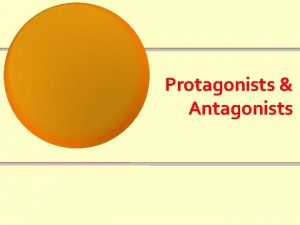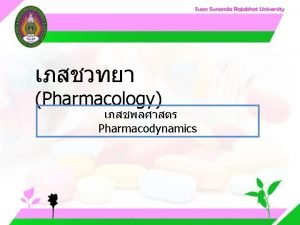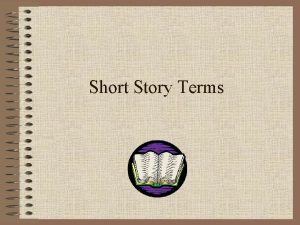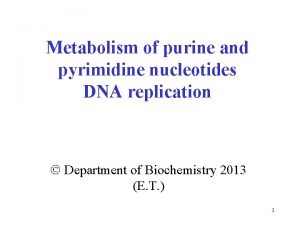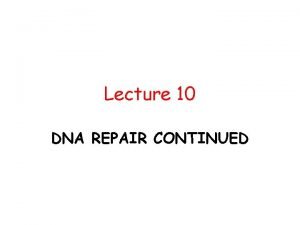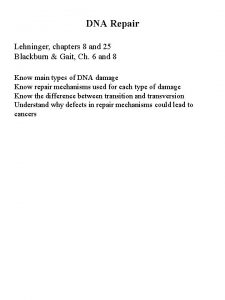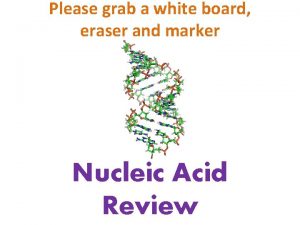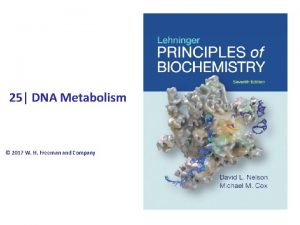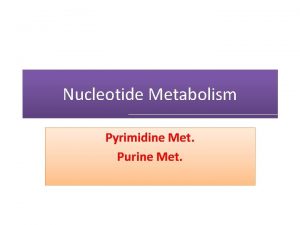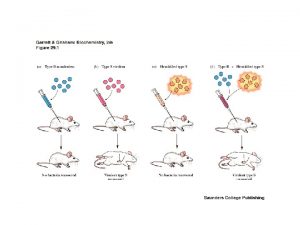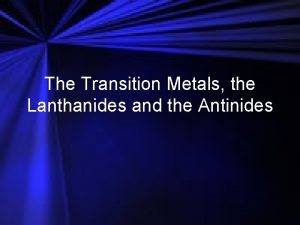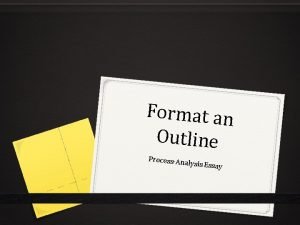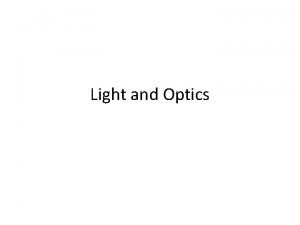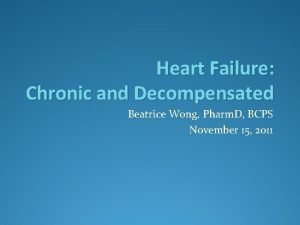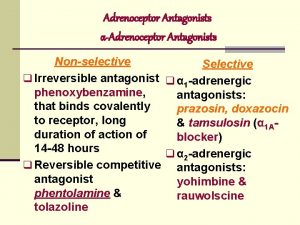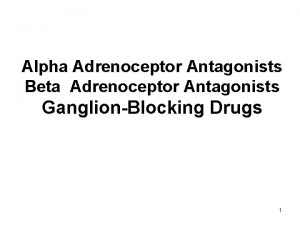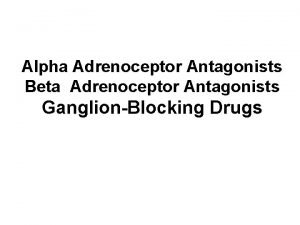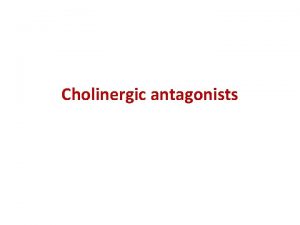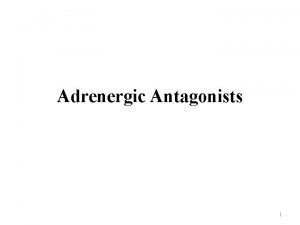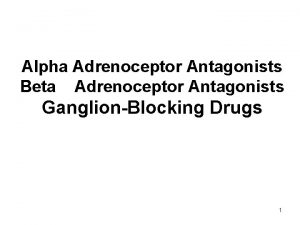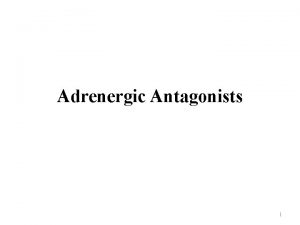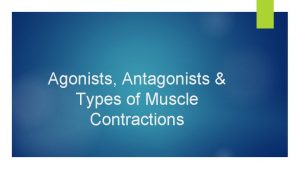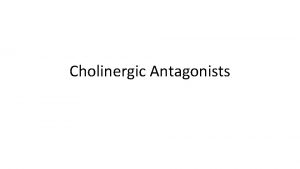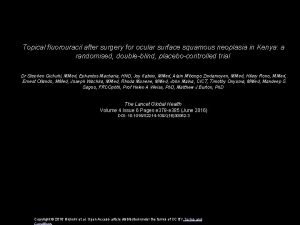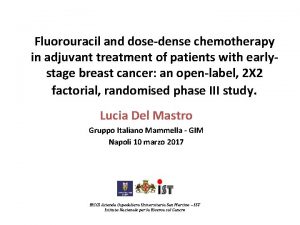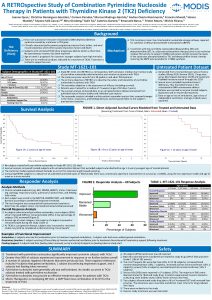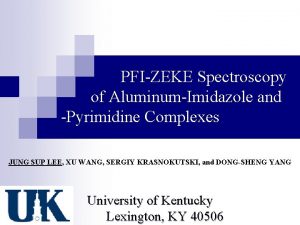Pyrimidine antagonists 5 Fluorouracil 5 FU Uses In

![Cytarabine 4 -Amino-1 -β-D-arabinofuranosyl-2 -[1 H]-pyrimidinone or 1 -β-D-Arabinofuranosylcytosine Uses It is used in Cytarabine 4 -Amino-1 -β-D-arabinofuranosyl-2 -[1 H]-pyrimidinone or 1 -β-D-Arabinofuranosylcytosine Uses It is used in](https://slidetodoc.com/presentation_image_h/140bd3343d49076835cbe13170ffc78e/image-2.jpg)






















- Slides: 24

Pyrimidine antagonists 5 -Fluorouracil (5 -FU) Uses In the treatment of colorectal cancer, and treatment of hepatic metastasis resulting from colorectal cancer. Mode of actions It inhibits synthesis of thymidine from uracil as 5 -position is occupied with fluorine atom. 5 -FU must be phosphorylated to the nucleotides (5 -FUMP), and 5’Fluoro-2 -deoxyuridine onophosphate (5 -Fd. MP) to be active which bind tightly with thymidylate synthetase and inhibit the eventual synthesis of DNA. After conversion into 5 -FUTP, is incorporated into RNA and inhibits RNA processing of m. RNA and r. RNA, and may cause errors in base pairing during RNA trancription Antineoplastic Drugs 1
![Cytarabine 4 Amino1 βDarabinofuranosyl2 1 Hpyrimidinone or 1 βDArabinofuranosylcytosine Uses It is used in Cytarabine 4 -Amino-1 -β-D-arabinofuranosyl-2 -[1 H]-pyrimidinone or 1 -β-D-Arabinofuranosylcytosine Uses It is used in](https://slidetodoc.com/presentation_image_h/140bd3343d49076835cbe13170ffc78e/image-2.jpg)
Cytarabine 4 -Amino-1 -β-D-arabinofuranosyl-2 -[1 H]-pyrimidinone or 1 -β-D-Arabinofuranosylcytosine Uses It is used in acute myelocytic leukemia, and as antiviral. Antineoplastic Drugs 2

a. Purines antagonists 6 -Mercaptopurine Uses: Treatment of leukemias. Mode of action: It inhibits purine biosynthesis as it replaces hypoxanthene, which is a natural intermediate in syntheses of nucleic acid purine bases. N. B. 6 -mercaptopurine is rapidly metabolized by xanthene oxidase enzyme, which is responsible for oxidation of hypoxanthene and xanthene into uric acid. So when 6 -mercaptopurine is co-administered with allopurinol (xanthine oxidase inhibitor) its half-life will be increased. Antineoplastic Drugs 3

6 -Thioguanine Uses: It is used in acute myelocytic leukemia in combination with cytarabine. Adverse reactions: Bone marrow depression and orogastrointestinal damage are the main adverse reactions. Antineoplastic Drugs 4

III- Antibiotics a- Anthracyclines Anthracycline are antibiotics, mostly tetracyclic, derived from anthraquinone Doxorubicin is probably the most important anticancer drug available because of its relatively broad spectrum of activity. These compounds intercalate with DNA, the planar ring structure is inserted approximately perpendicularly to the long axis of the DNA double helix. Antineoplastic Drugs 5

B-Mithramycin or Plicamycin (Mithracin) ® Mithramycin. The aglycone is chromomycine, the sugars are: A, C, and D = olivose; B = oliose, E = mycarose Uses Testicular carcinoma Antineoplastic Drugs 6

c- Bleomycin (Blenoxane®) It is glycopeptide Mode of action Bleomycin causes single and double strand breaks in DNA. Uses Basal cell carcinoma, and pericardial scleropathy. It has modest activity in a variety of squamous cell cancers. Also, in combination therapy especially it lacks bone marrow depression and immunosuppression Antineoplastic Drugs 7

Etoposide (Ve. Pesid®) Etoposide causes strand breaks in DNA, which is probably mediated by interaction with topoisomerase II. Etoposide is a semisynthetic derivative of podophylltoxin small-cell lung cancer testicular carcinoma Antineoplastic Drugs 8

The alkaloids of the periwinkle plant (Vinca rosea) -They are dimeric indole-dihydroindole derivatives Mode of action They bind to tubulin, arresting mitosis at metaphase Antineoplastic Drugs 9

Vincristine sulfate (Oncovin®) Uses leukemias, lymphomas, sarcomas, and some carcinomas Vinblastine sulfate (Velban®) Vinblastine, the more active compound, has had much wide clinical application, including solid tumors, especially in combination with such drugs as cisplatin and BLM (bleomycin) testicular tumor advanced Hodgkin’s disease breast carcinoma Antineoplastic Drugs 10

Prophase Mitosis Anaphase Metaphase Telophase Antimitotic agents bind to microtubuli Supression of microtubuli dynamics Metaphase arrest

Vinca alkaloids

Taxol One of the newest antimitotic agent to be approved (1993) for clinical use is the diterpenoid taxol. It is obtained from the bark of the pacific yew tree, Taxus brevifola. Uses leukemias, sarcomas, and lung cancer ovarian and breast carcinoma Antineoplastic Drugs 13

Taxanes First isolated from bark of Western / Pacific yew (Taxus brevifolia) NIH screening of plant extracts 1960 s

Miscellaneous cytostatic agents 1 - Platinum compounds Cisplatin (Platinol) ® Diamminedichloroplatinum It has divalent platinum bound to two potential leaving groups; the chloride ions; in trans position to the chlorides are two NH 3 groups bound irreversibly and in firm coordinate covalent bonds. Antineoplastic Drugs 15

Mode of action In vitro studies have revealed that only cis form can form interstrand crosslinks between adjacent guanine residues in DNA. Uses testicular and ovarian cancer in bladder and cervical carcinomas and head and neck cancer, as well as in osteogenic sarcoma and non-small cell lung, esophageal, and gastric carcinomas. Antineoplastic Drugs 16

Antineoplastic Drugs 17

Carboplatin differs from cisplatin in that it has a bidentate dicarboxylate (the ligand is Cyclo. Butane Di. Carboxylic Acid, CBDCA) in place of the two chloride ligands, which are the leaving groups in cisplatin. Antineoplastic Drugs 18

Hydroxyurea This simple synthetic compound interferes with DNA synthesis by inhibiting ribonucleoside reductase. -Its main use is lowering leucocyte count in chronic myelogenous leukemia. -melanoma Antineoplastic Drugs 19

Colchicine From Meadow-saffron, Colchicum autumnale (Tidløs) seeds Binds to microtubuli - metaphase arrest, too toxic too be used in cancer treatment Used to treat gout (podagra)

Camptothecins First isolated Camptotheca acuminata (Chinese tree) NIH screening Later found in several plants Topotecan Hycamtin® Irinotecan Campto® Semisynth. inhib. DNA topoisomerase II, DNA strand breakage

Tyrosine-Kinase Inhibitors

Imatinib Glivec® Leukemia types Gefitinib Iressa® - Not in N. Lung cancer

Histone deacetlylase Inhibitors, HDACIs Structure of the approved HDACIs and some HDACIs in clinical trial SAR Antineoplastic Drugs 24
 Protagonist antagonist and agonist
Protagonist antagonist and agonist Antagonist drug
Antagonist drug Static character
Static character Fascia thoracolumbalis
Fascia thoracolumbalis Symbols in short stories
Symbols in short stories Iambic pentameter romeo and juliet
Iambic pentameter romeo and juliet Pyrimidine
Pyrimidine Site:slidetodoc.com
Site:slidetodoc.com Pyrimidine dimer
Pyrimidine dimer Purine examples
Purine examples Pyrimidine dimers
Pyrimidine dimers Dna structure labeled hydrogen bonds
Dna structure labeled hydrogen bonds Rec a
Rec a Biosynthesis of purine nucleotides
Biosynthesis of purine nucleotides Pyrimidine structure
Pyrimidine structure Is text a multimedia
Is text a multimedia 10 uses of transition elements
10 uses of transition elements Your romantic partner always uses the same shampoo
Your romantic partner always uses the same shampoo A topic outline uses
A topic outline uses Applications of trigonometry in daily life
Applications of trigonometry in daily life Properties of lights
Properties of lights Thionutri syngenta uses
Thionutri syngenta uses Buffalo chopper uses
Buffalo chopper uses Dopamine uses
Dopamine uses Program prim
Program prim
